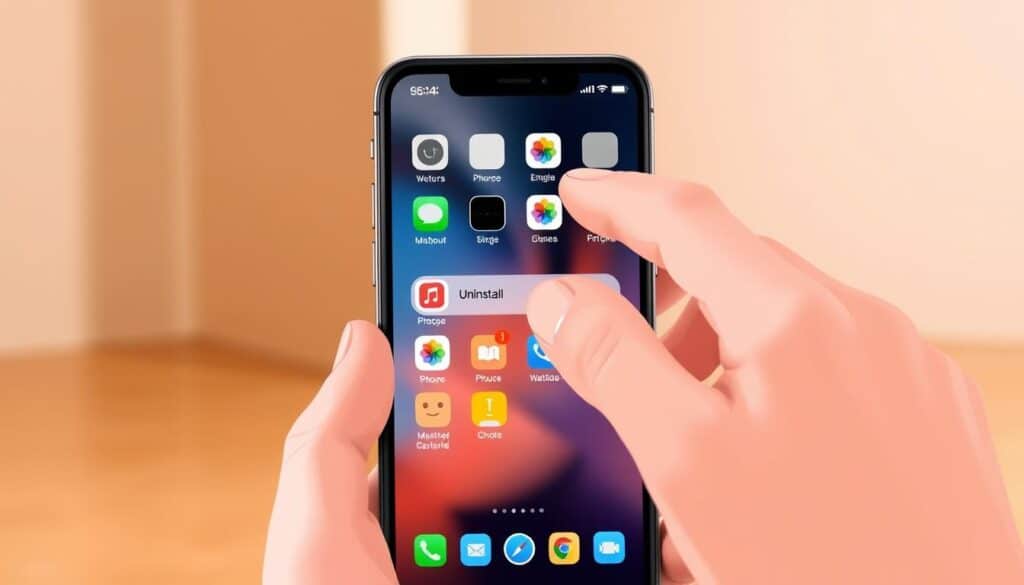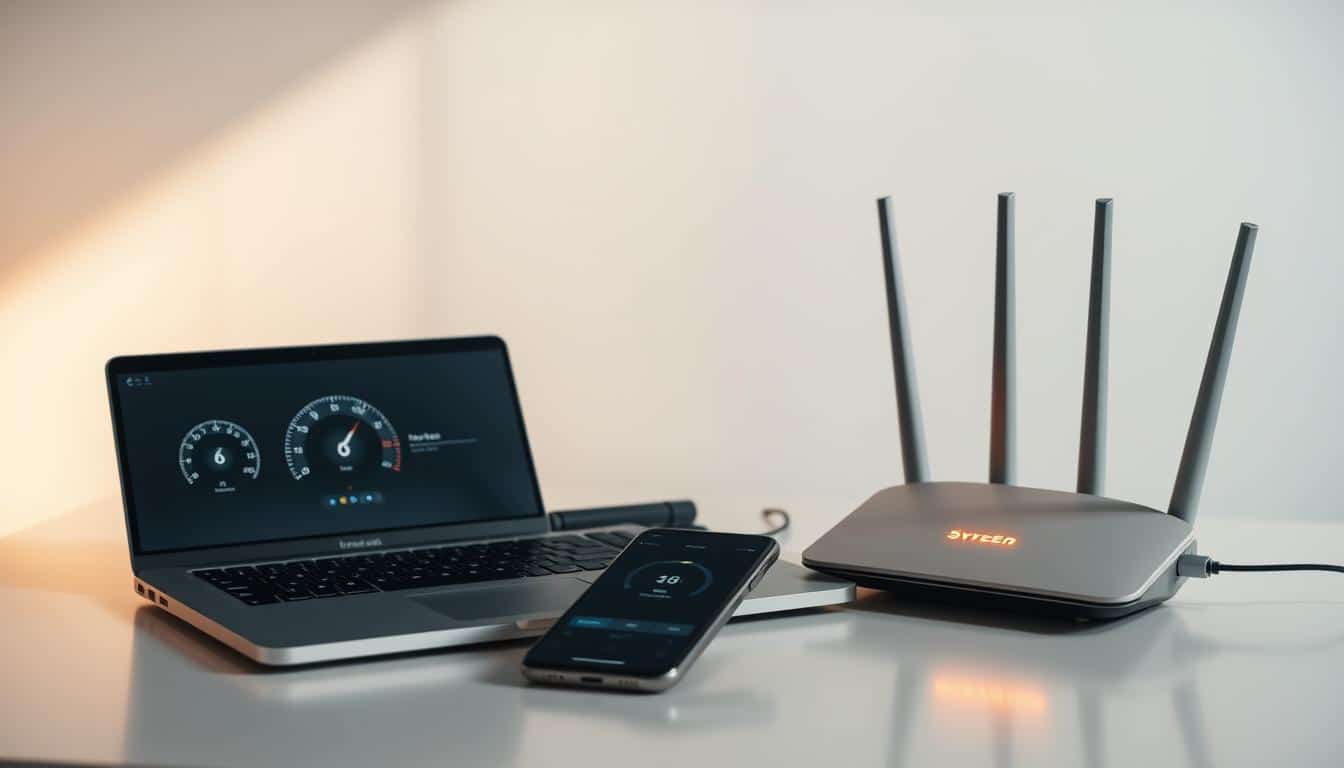This guide shows you how to remove apps from your phone. It’s for anyone in the United States wanting to clear up space or make their phone faster. It gives easy steps for everyone to follow.
Anúncios
It covers uninstalling apps on Android devices, like Google Pixel and Samsung, and iPhones. Learn how to deal with apps that came with your phone, manage your subscriptions, and solve common problems. It tells you when to delete apps or just disable them.
You’ll find out how to get more storage and a longer battery life. It also helps reduce data use and security risks from old apps. This advice is for non-developers and uses simple to medium-hard methods. Hard methods come with warnings.
Anúncios
Meta title: Uninstall Apps on Your Phone: Quick Guide. Meta description: Discover how to remove apps from your phone to increase storage, boost performance, and keep your device safe. Step-by-step guide for both Android and iPhone users.
Key Takeaways
- Learn how to uninstall apps on my phone for both Android and iPhone.
- Removing unused apps helps free up phone storage and improve speed.
- Offloading or disabling can be safer than deleting for some apps.
- Sign out of accounts and back up data before you delete apps.
- Know when to use built-in settings vs. store-based removal methods.
Why You Should Uninstall Unused Apps to Improve Phone Performance
Unused apps take up space and hurt your phone’s performance. When your phone’s storage is full, it can’t handle temporary files well. This makes your phone slower when you’re switching between apps or doing more than one thing.
Apps like Instagram, TikTok, and Spotify use a lot of space for media and caches. Getting rid of these can free up space and make your phone faster. Removing big games and social apps can really improve your phone’s speed.
Some apps run in the background without you knowing. These apps use your phone’s CPU and network, which can drain your battery and use extra data. Stopping or removing these apps can save your phone’s battery and data.
On Android, you can control background app activities in the settings. iOS users can use Background App Refresh for the same purpose. Both methods help save battery and reduce data use from apps you hardly use.
Old apps can be a security risk because they might have unpatched flaws. They could also access your contacts, photos, or location without any good reason. Deleting these apps makes your phone safer and protects your privacy.
Checking your apps regularly helps with storage, battery, and privacy. Get rid of apps you don’t use, update the ones you keep, and check their permissions. This keeps your phone working well and safe from risks posed by unused apps.
How to Identify Which Apps to Remove
Start by seeing how you use your phone. Find out which apps you don’t use but that take up space or battery. Built-in tools can help you do this quickly and accurately.
On an iPhone, go to Settings and then Screen Time to see your app use. This shows how much time you spend on each app and which ones you don’t use much. For Android, check Digital Wellbeing or Settings’ Apps section for your app activity.
If an app hasn’t been opened for a while or is rarely used, think about removing it. Especially if it’s taking up resources without being used much.
Then, check how much space apps take up. On an iPhone, go to Settings, then General, then iPhone Storage to see the space used by each app. This can show you which apps are the biggest.
Android users, look in Settings under Storage or Apps, then [App] to find out how much space, data, and cache an app uses. A big cache or lots of Documents & Data are hints at what you might need to clean out.
Before removing an app you seldom use, try clearing its cache or deleting leftover files. This can give you more space without losing any important data.
Deciding to remove an app? Think about what you’ll need in the future. To fully remove an app and most of its data, uninstall it. For iPhone users, offloading an app keeps your data and documents but removes the app itself. Android users can disable system apps they can’t uninstall to stop them from updating or running in the background.
To decide quickly what to do with each app, use this checklist:
- Keep apps you use a lot and contain important data.
- If you use an app sometimes but it has important data, offload it on an iPhone or backup data first.
- For preinstalled apps you never use: disable them to save resources.
- If you barely use an app and it can be replaced, uninstall it to save space and energy.
| Action | What it removes | When to choose |
|---|---|---|
| Uninstall | App binary and most app data | Replaceable apps or those tied to no needed data |
| Offload (iOS) | App binary only; documents and data kept | Apps you may reinstall later and want restored state |
| Disable (Android) | Stops app, removes updates, keeps factory version | Preinstalled or system apps you cannot uninstall |
| Clear cache | Temporary files and cached media | Recover space quickly without losing app settings |
How to uninstall apps on my phone?

Before you start, make sure to back up important things. Use iCloud or Google Drive to save your app data. This way, you can get back your game saves or notes later. A quick backup ensures you won’t lose anything important.
Always sign out from apps, especially those with subscriptions or extra security. This keeps your accounts safe. For apps like Spotify or banking ones, save your chats and settings. And don’t forget to clear your payment information or any connections to devices.
Preparing before removal: backups and account sign-outs
Make a checklist. Ensure everything’s synced, back up using iCloud or Google, and save stuff like contacts. Then, sign out of your app accounts and turn off app-specific security features. Doing these steps makes it easy to reinstall apps later.
What to expect after uninstalling an app
Uninstalling an app usually gets rid of it and most data. But on Android, some unused files might stay behind. Notifications and app activities stop right away. Remember, you need to cancel any subscriptions yourself to avoid extra charges.
Reinstalling apps and restoring data when needed
If you reinstall an app from the Google Play Store or Apple App Store, just log in to get your data back. iOS lets you keep documents even when an app is not installed. Without cloud backup? Use the backup you made to restore your app data easily.
Uninstalling Apps on Android Phones
Removing apps helps clear space and reduce background tasks on Android phones. Here are easy ways to delete apps on stock Android, Samsung One UI, and via the Google Play Store. Choose the best method for your device.
Step-by-step: Google Pixel and stock Android
For Pixel and stock Android, press and hold the app icon on your Home screen or App Drawer. Then, drag it to Uninstall or click on App info to find the Uninstall option.
To pick from a list, go to Settings > Apps & notifications > See all apps. Choose an app, confirm the uninstall and delete data if asked.
Step-by-step: Samsung One UI and other OEM skins
On Samsung phones, press and hold an app icon. You can tap Uninstall or Remove from Home. To manage Galaxy Store apps, open the store.
Go to Settings > Apps, choose an app, and hit Uninstall. If the app can’t be removed, you might see Disable. This is also true for other skins like MIUI or OxygenOS. Look for App info for Uninstall/Disable.
Using Google Play Store to remove apps
Open Play Store, tap your profile, and go to Manage apps & device > Manage. Choose an app or more, then tap Uninstall. This deletes apps tracked by Play Store.
This view shows last updates and permissions. This method is great for apps from Google Play and helps with removing many apps at once.
Uninstalling Apps on iPhone (iOS)
Cleaning apps off your iPhone improves its speed and frees up storage quickly. Here, you’ll find easy steps to remove apps. It involves using Settings to offload or completely delete apps, and how to keep your data safe in iCloud.
Removing apps from the Home Screen
Press any app icon and hold it until a menu pops up. Choose Remove App and then tap Delete App. This is how you remove apps you don’t need anymore.
If not wanting to lose data, move the app to the App Library by choosing Remove from Home Screen on iOS 14 or later. For removing multiple apps, long-press and select Edit Home Screen. This puts your screen in jiggle mode. Then, tap the minus icon on each app you wish to delete.
Using Settings to offload or delete apps
Go to Settings > General > iPhone Storage to see your apps by size. Click on an app for options to Offload or Delete it. Offloading saves your documents and data but removes the app itself.
To automatically offload apps you’re not using, turn on Offload Unused Apps in Settings > App Store. It saves space without losing your settings or data. Choose Delete App to get rid of both the app and its data for good.
Managing app storage in iCloud and local device
Check Settings > [your name] > iCloud > Manage Storage to see apps storing backups in iCloud. Make sure to check WhatsApp and similar apps for backups before deleting them.
To save space, you can transfer photos and videos to iCloud Photos or Google Photos. Always check if your important app data is backed up in iCloud or another cloud service before removing apps you depend on.
| Task | Where to Do It | Result |
|---|---|---|
| Remove app from Home Screen | Long-press icon, choose Remove | App hidden or ready for delete without losing data if moved |
| Delete app completely | Home Screen or Settings > iPhone Storage | App and local data removed from device |
| Offload unused apps | Settings > App Store or iPhone Storage | App binary removed; documents and data retained |
| Check cloud backups | Settings > [your name] > iCloud > Manage Storage | See iCloud app storage and confirm backups before removal |
| Free up media space | iCloud Photos or Google Photos | Large photos and videos moved off device to save local storage |
Dealing with Preinstalled and System Apps
Many phones come with extra apps from carriers and manufacturers. Some can be easily removed. But others are part of the system and you can’t get rid of them without special tools.
Understanding which apps can be uninstalled vs disabled
On Android, go to Settings > Apps and select an app. You’ll see if you can Uninstall or Disable it. Uninstalling gets rid of the app for you; disabling returns it to its original version and prevents it from running or updating.
iPhone users can delete many Apple apps like Calculator or Stocks. But the main system stays. Removing some apps may affect other functions, so be careful.
Using ADB or manufacturer tools for advanced removal (risks)
Advanced users can use adb commands to remove unwanted apps. For example, adb shell pm uninstall –user 0 package.name. This only removes the app for the current user and might affect other features.
Tools from Samsung or LG give more removal control. They can delete or bring back packages. However, using these tools can void your warranty, stop updates, or make your phone unstable. Always back up your phone and know the package names and how to reverse your actions before you start.
Alternatives: disabling, hiding, or restricting permissions
If removing system apps isn’t safe, you can disable them. This stops updates and background activity but keeps the app on your phone.
Change app permissions to reduce data sharing and save battery. This won’t change your system files.
Android users can hide apps from the Home Screen with folders or other options. Hidden apps are still there but out of view, which is good for important but unneeded apps.
Freeing Up Space Beyond Uninstalling Apps
Removing apps is a start, but phones get full in other ways too. A few smart moves can clean out junk, speed up your device, and simplify backups. Here are some tips for Android and iPhone users to free up space without losing precious data.
Clear app cache and residual files
For Android, head to Settings > Apps > [App] > Storage. Then, choose Clear Cache or Clear Data to get rid of temp files. This action, especially with apps like Spotify or Chrome, can save you a lot of space.
iPhones don’t always have a cache-clearing option. You can offload or reinstall apps to remove their cache. To get rid of leftovers from deleted apps, use the Files app or a reliable file manager.
Delete downloads, duplicate files, and large media
Go through your Downloads folder. Get rid of things like old installers, PDFs, or documents you don’t use anymore. This simple step often frees up a lot of space quickly.
Use Google Photos or your iPhone’s tools to remove duplicate pictures and similar images. This helps you not to waste space on almost identical photos that silently take up room.
Look for big video files, old voice memos, and messages you no longer need. Removing these or moving big videos to a computer can quickly clear up lots of space.
Using cloud storage and automatic offloading
Upload photos and videos to iCloud Photos, Google Photos, OneDrive, or Dropbox. This keeps your originals safe online while leaving smaller versions on your device. It’s a great way to save space and still keep your high-quality backups.
Set apps to back up data to the cloud automatically. Android users should check Google Drive settings for backing up app data and media. iPhone folks can manage iCloud settings for apps and set up iCloud Backup. This will help you keep less data on your phone.
- Tip: Schedule a monthly cleanup: clear app cache Android selectively, delete duplicate photos, and review cloud storage phone options.
- Tip: Keep at least 10–15% of storage free for system tasks and smoother performance.
Managing Subscriptions and Accounts Linked to Removed Apps
Before removing an app, first take care of your billing and accounts. Cancel any subscriptions and take out saved payment information to avoid surprise charges. It’s good to use a checklist to make sure you don’t miss anything.
Canceling paid subscriptions before uninstalling
To cancel subscriptions on an iPhone, go to Settings > [your name] > Subscriptions. For Android users, go to Google Play > Payments & subscriptions. If you’re billed directly by a service like Netflix or Spotify, go to their website to cancel. Keep emails that confirm your cancellation in case there’s a problem later.
Removing saved payment methods and linked accounts
Delete any saved cards or PayPal details in the app’s billing settings. If you used Apple Pay or Google Pay for the app, remove those cards too. You can stop third-party access via your Google Account > Security > Third-party apps, or check each service’s settings to remove access.
Checking for recurring charges after app removal
After uninstalling, watch your bank and card statements for a billing cycle. Contact the support team and your card issuer if you see any charges you didn’t expect. Ask for refunds for charges after you’ve cancelled. Keep all communication as proof.
Follow these steps to keep your subscriptions and payments in check.
| Action | iPhone Steps | Android Steps | Why it matters |
|---|---|---|---|
| Cancel app subscription | Settings > [your name] > Subscriptions, select and cancel | Google Play > Payments & subscriptions > Subscriptions, select and cancel | Stops future billing and documents end date |
| Remove payment method app | Delete card in app, remove from Apple Wallet if added | Delete card in app, remove from Google Pay if added | Prevents charges if app account stays active |
| Revoke linked accounts | Check service account page; revoke access in Apple ID settings when available | Use service account page; revoke in Google Account > Security if used | Blocks data access and stops token-based reactivation |
| Monitor recurring charges app | Review Apple Card or bank statements; compare billing dates | Review bank or card statements tied to Google Play purchases | Catch and resolve unexpected charges quickly |
Troubleshooting Common Uninstall Problems
![]()
Having trouble uninstalling an app? Here are some checks for Android and iPhone. They cover common issues plus tips for system errors. Always back up data before making big changes.
App won’t uninstall — permission and administrator settings
Some Android apps need administrator permission to be removed. Go to Settings > Security > Device admin apps. There, turn off the app’s admin permission. Make sure you’re using the main account and look for any parental or management blocks.
On iPhones, app removal is usually straightforward. But work or management apps may have restrictions. Talk to your IT admin if you can’t delete an app due to work or Mobile Device Management policies.
Error messages and storage system issues
Seeing “App not installed” or “Installation failed”? It could be corrupt data or not enough space. Clear the app’s cache and delete unnecessary files before trying again. On Android, also try clearing Google Play’s cache or resetting app preferences.
Keep getting error messages? Try Safe Mode to stop third-party apps and then try to uninstall. Back up your phone to a computer. Then use a file manager to clean up storage.
When to factory reset as a last resort
Consider a factory reset only if nothing else works. It’s for when many apps don’t work, the phone is slow, or you can’t remove malware. This will erase all apps and data.
Before resetting, back up everything to Google Drive, iCloud, or your computer. After resetting, only put back what you really need. This helps avoid old problems.
Best Practices to Keep Your Phone Organized Going Forward
Keeping a phone tidy saves time and avoids slowdowns. Stick to a few simple habits. These include managing apps, storage, and permissions. Start these habits now to make future cleanups easier.
Regular app audits and monthly maintenance checks
Set a reminder to audit your apps every month. Look at screen time, last use, and storage usage.
iPhone and Android have tools to help decide which apps to remove. Also, clean caches and update apps to maintain performance.
Using folders, app libraries, and minimal home screens
Group apps into folders like Work, Social, and Utilities. Reducing clutter makes your phone easier to use.
Keep only necessary apps on your home screen. For others, use the App Library on iPhone or Android’s app drawer.
Consider having a single-home-screen setup with essential widgets. It helps you stay focused and reduces random app opening.
Installing apps mindfully: reviews, permissions, and size
Before installing, read app reviews and check their size and permissions. Stick to well-known developers like Google, Apple, Microsoft, or Adobe if possible.
Try apps before buying. Use free versions or trials. Steer clear of apps with too many permissions requests.
| Task | Frequency | Tools to Use | Why It Helps |
|---|---|---|---|
| App audit monthly | Monthly | iPhone Storage, Android Storage Manager, Screen Time | Find unused apps, free space, and reduce background activity |
| Organize apps into folders | As needed | Home screen editor, App Library, Launcher settings | Reduce clutter, faster app access, fewer accidental opens |
| Clear caches and update apps | Monthly | App settings, storage tools | Improve speed and fix bugs |
| App permissions check | Every install and quarterly review | Privacy settings, Play Store, App Store | Protect privacy and reduce unnecessary access |
| Review subscriptions and linked accounts | Quarterly | Account settings, billing portals | Avoid recurring charges from forgotten apps |
Conclusion
This guide makes uninstalling apps easy. First, find unused apps with Screen Time on iPhone or Digital Wellbeing on Android. Then, back up important info and log out of accounts. Finally, follow our easy steps for removing apps.
To make more room on your phone, clean out app caches and delete big photos and videos. You can also move files to iCloud or Google Drive. For iPhone, offloading apps saves space. On Android, clearing cache helps too, without losing your settings.
Be careful with built-in apps and tools like ADB. It’s usually safer to disable or hide them than remove them completely. Always keep your apps up to date. Check their permissions and subscriptions often. Do a phone check-up every month to keep it speedy and safe. If you’re not sure about a step, ask for help from Apple Support or Android support from your phone’s brand.
FAQ
How do I uninstall apps on my phone?
What is the difference between uninstalling, offloading, and disabling an app?
Will uninstalling an app cancel my subscription?
How can I tell which apps are using the most storage or battery?
What should I do before uninstalling an app that stores important data?
How do I remove preinstalled or carrier apps that won’t uninstall?
Why won’t an app uninstall on Android?
How can I clear app cache and residual files without uninstalling?
Will deleting an app remove its account and stored payment methods?
How do I reinstall an app and restore its data?
Can uninstalling apps improve battery life and performance?
What if I see recurring charges after I deleted an app?
Is it safe to use third-party uninstallers or cleaner apps?
When should I consider a factory reset instead of uninstalling apps one-by-one?
How often should I audit apps and manage storage?
Conteúdo criado com auxílio de Inteligência Artificial



